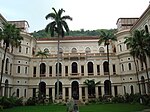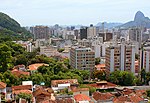Cosme Velho

Cosme Velho is a neighborhood in the South Zone of Rio de Janeiro, adjacent to Laranjeiras. Its main street is Rua Cosme Velho, an extension of Rua das Laranjeiras. Cosme Velho is frequently visited by tourists.The Estação de Ferro do Corcovado (terminus of the Corcovado Rack Railway) is located here. Trains carry passengers from there to the summit of Corcovado Mountain and the statue of Christ the Redeemer. The neighbourhood also includes the picturesque Largo do Boticário, which consists of a small square enclosed by several neocolonial style houses, built in the 1920s. The houses were constructed using materials from much older buildings in the city's Centro district which had been demolished. There are two houses from the first half of the 19th century at the entrance to the square. The writer Joaquim Maria Machado de Assis lived in a house at 18 Rua Cosme Velho from 1883 until his death in 1908. Machado acquired the nickname "Bruxo do Cosme Velho" ("Wizard of Cosme Velho"), supposedly because he was in the habit of burning his discarded documents in a cauldron. The house has since been demolished and an apartment block has been built in its place.
Excerpt from the Wikipedia article Cosme Velho (License: CC BY-SA 3.0, Authors, Images).Cosme Velho
Rua Filinto de Almeida, Rio de Janeiro Cosme Velho
Geographical coordinates (GPS) Address Nearby Places Show on map
Geographical coordinates (GPS)
| Latitude | Longitude |
|---|---|
| N -22.942777777778 ° | E -43.2 ° |
Address
Rua Filinto de Almeida
Rua Filinto de Almeida
22241-140 Rio de Janeiro, Cosme Velho
Rio de Janeiro, Brazil
Open on Google Maps









